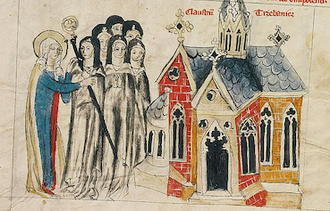Formation and Establishment of Female Consecrated Life in England

The formation and establishment of female consecrated life in Anglo-Saxon England was different to most other countries. This was because, while there were small numbers of all-male religious communities, there were no all-female religious communities. The majority of religious communities were double houses consisting of monks and nuns living side by side and presided over by a woman. Female consecrated life also differed in that there were large numbers of singly consecrated women. Initially these women were mainly vowesses but later there were also anchoresses.
The majority of monasteries in Anglo-Saxon England were founded by a devout aristocratic woman who presided over two separate communities of monks and nuns. These abbesses were not priests but their abbeys were places of great learning which created a cultural rising of the people. The abbesses were theologians and received the same learning as monks. They taught and trained future bishops. For example, five men taught by St Hilda later became bishops. The abbesses also had the synodal vote. St Hilda both hosted and voted at the Synod of Whitby and the Abbess Aelfled voted at the Synod of Nidd where she was highly influential.
The abbesses were sought out for their spiritual counsel. When Aldfrith, King of Northumbria died, he chose two abbesses to whom to convey his last words and instructions. In the later church or the church in other parts of Europe it would have been the bishop who received such a prestigious call, but in Anglo-Saxon England it was often the abbess. These women enjoyed great power and prestige. They presided over both abbeys and society as a whole.
Another form of female consecrated life common in this period was the singly consecrated way of life. The most popular form of this was that of the 'Vowess' or consecrated widow.
The Order of Consecrated Widows is one of the oldest forms of female consecrated life. It existed in the early church and is mentioned in the New Testament (1 Timothy 5: 3-15). In order to be enrolled into this order a woman had to have married only once and to have lived a life of prayer and service. Vowesses very quickly became well established in the Anglo-Saxon Church and are mentioned in the Penitential of Archbishop Theodore of Canterbury (668-90) and the Confessional of Egbert, Archbishop of York (732-66). Egbert's Pontifical includes a blessing of widows and their habit and a rite for consecrating widows during Mass. There are also other mentions of vowesses in other diocesan records.
Vowesses were answerable to their diocesan bishops and wore a particular costume of mantle, veil and ring. They took a vow of chastity and owned their own property and lived independently.
The Anglo-Saxon double monasteries were destroyed by the Danish raids which began in the late eighth century. They were targeted due to their wealth. The raids continued for another hundred years by which time the Vikings had acquired most of the Anglo-Saxon Kingdoms. The great abbesses were deposed and with them went their unique and influential role.
The vocation of Vowess continued right up until the reformation. After the raids, female consecrated life also began to emerge in the form of the anchoress. This movement had its roots in early Christianity from St Thecla of Iconium. Following the destruction of the double monasteries, the only path left for spiritual women was that of singly consecrated vows. Eventually, however, the anchoresses provided a focal point for new forms of community religious life to grow up around them. These religious communities were all female and women there never achieved the influence of the Anglo-Saxon abbesses. Sadly, all forms of female consecrated life in England were eventually destroyed by the reformation.
After the reformation, a new form of active religious life was promoted by the Englishwoman Mary Ward and eventually this form of consecrated life began to flourish. However, these consecrated women did not have the synodal vote. Recently Pope Francis has restored the synodal vote and granted it to both lay and consecrated women. The question remains as to whether women will also be granted the powers of governance that they once had in the early Anglo-Saxon church.
Debra Maria Flint's first book Look back to the Future: Consecrated Women in England was published in April 2021. Her forthcoming book No Place for a Woman will be published in March 2024 by Lantern Publishing and Media. No Place for a Woman presents the historical case for the ordination of women within Catholicism.
The Margaret Beaufort Institute of Theology will host an insightful event on 'Women and Diakonia: The Ministry of Women and Diaconal Ordination in the Catholic Church,' taking place from Friday, November 24th to Saturday, November 25th, 2023. At Cambridge University.
You can join either onsite or online for this significant synodal discussion.
For more details and ticket information, click here: www.eventbrite.co.uk/e/the-ministry-of-women-and-diaconal-ordination-in-the-catholic-church-tickets-545983400047?aff=oddtdtcreator


















